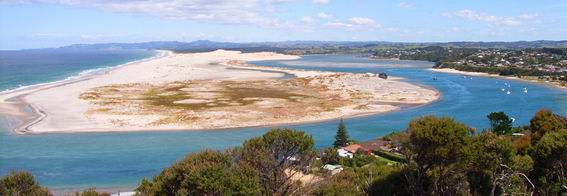8.1 Introduction
Coastal waters in Northland are affected primarily by contaminants sourced from land through river/stormwater runoff and to a lesser extent by direct discharges from industry and vessels. These contaminants are diluted and dispersed by mixing with ocean water and in some cases degrade or settle to the sea bed. The balance between sources and sinks for a site at any given time determines local water quality.
Northland's coastline includes 14 major harbours, numerous other small estuaries and extensive sections of rocky and sandy open coast. On the open coast tidal mixing and flushing combined with low freshwater input generally ensure very high water quality. However, all of Northland's major rivers discharge into harbours providing very high freshwater input in areas of limited mixing. These harbours are also often near towns and industry and consequently have lower water quality than open coastal sites.

Mangawhai harbour and spit.
Regional Policy Statement objectives
The Regional Policy Statement for Northland (NRC 2002) contains a number of objectives relating to coastal water quality. These seek to maintain and where possible improve coastal water quality in the Northland region, recognising the different levels of existing human impact in estuarine, harbour and open coastal areas.
The Regional Policy Statement (RPS) objectives are:
- The maintenance or enhancement of the water quality of coastal waters in Northland to be suitable, in the long term, and after reasonable mixing of any contaminant with the receiving environment and disregarding the effect of any natural events, for the purposes listed below:
- Estuaries and areas of inner harbours influenced by major river inflows – aquatic ecosystems, contact recreation and aesthetic purposes, cultural purposes.
- Other harbour areas and open coastal beaches and bays – as above, plus the gathering of shellfish for human consumption, cultural purposes.
- Open coastal waters – its natural state, cultural purposes.
- The reduction and minimisation of the quantities of contaminants which adversely affect water quality entering coastal waters, in particular those that are potentially toxic, persistent or bio-accumulative.
- Avoid, remedy or mitigate the adverse effects of discharges of contaminants on the traditional, cultural and spiritual values of water held by tangata whenua.
- The efficient and effective control and minimisation of the impact of oil pollution in the Coastal Marine Area (CMA).
The NRC works towards these objectives by controlling activities which impact on water quality and by monitoring water quality to detect long-term trends.
Environmental results anticipated
The following is the anticipated environmental results after the implementation of the coastal water quality policies in the RPS:
· Water quality suitable for desired purposes.
· Contaminants in water bodies reduced.
· The adverse effects of contaminants in water bodies and coastal waters be avoided, remedied or mitigated.
· That all new discharges of organic contaminants be via the best practicable option for treatment and disposal.
· Improved aquatic habitat.
